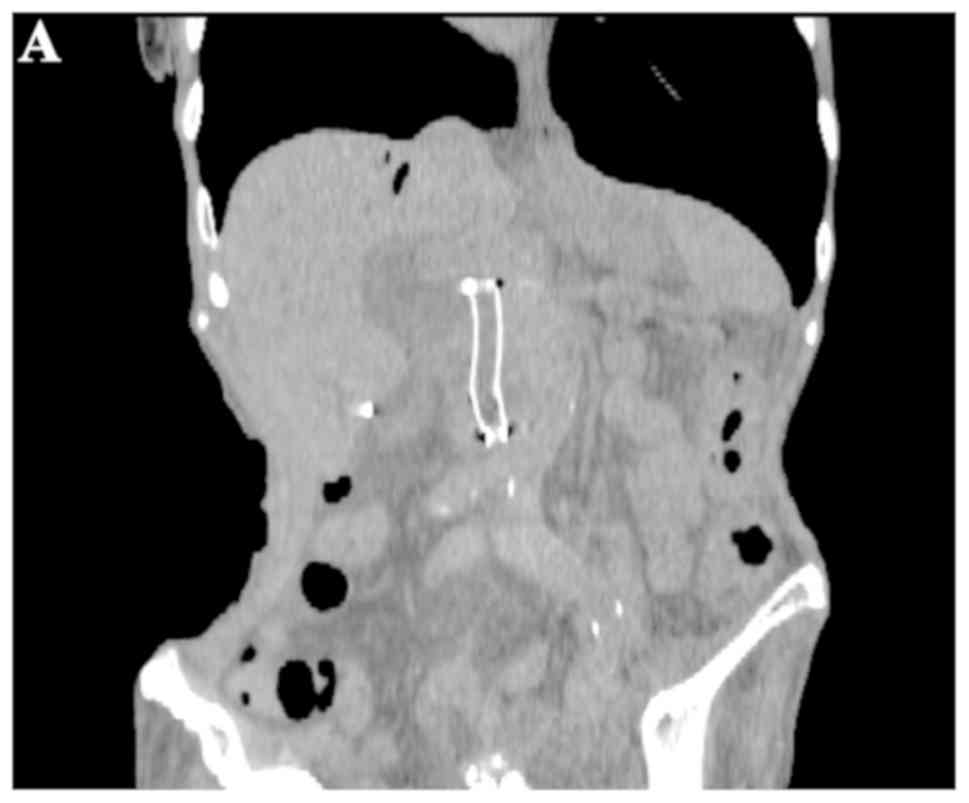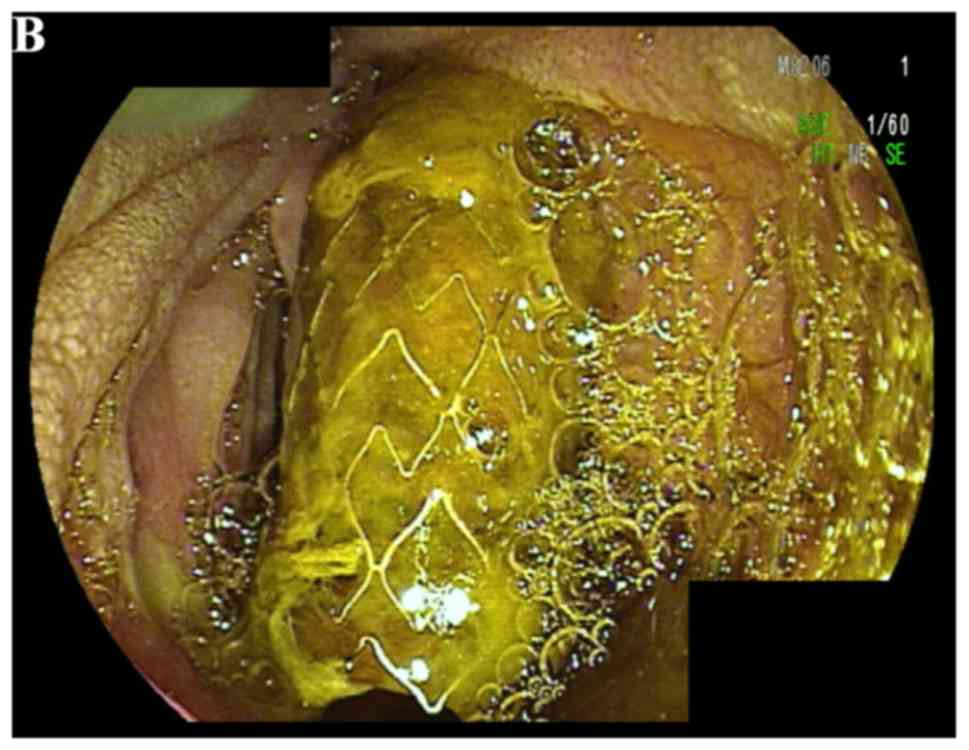|
1
|
Ukkonen M, Siiki A, Antila A, Tyrväinen T,
Sand J and Laukkarinen J: Safety and efficacy of acute endoscopic
retrograde cholangiopancreatography in the elderly. Dig Dis Sci.
61:3302–3308. 2016.PubMed/NCBI View Article : Google Scholar
|
|
2
|
Galeazzi M, Mazzola P, Valcarcel B,
Bellelli G, Dinelli M, Pasinetti GM and Annoni G: Endoscopic
retrograde cholangiopancreatography in the elderly: Results of a
retrospective study and a geriatricians' point of view. BMC
Gastroenterol. 18(38)2018.PubMed/NCBI View Article : Google Scholar
|
|
3
|
Tohda G, Ohtani M and Dochin M: Efficacy
and safety of emergency endoscopic retrograde
cholangiopancreatography for acute cholangitis in the elderly.
World J Gastroenterol. 22:8382–8388. 2016.PubMed/NCBI View Article : Google Scholar
|
|
4
|
Yun DY, Han J, Oh JS, Park KW, Shin IH and
Kim HG: Is endoscopic retrograde cholangiopancreatography safe in
patients 90 years of age and older? Gut Liver. 8:552–556.
2014.PubMed/NCBI View
Article : Google Scholar
|
|
5
|
Behlül B, Ayfer S, Sezgin V, Altay K,
Mustafa C, Cem C, Bilge O, Fatih A, Emrah A, Zafer B, et al: Safety
of endoscopic retrograde cholangiopancreatography in patients 80
years of age and older. Prz Gastroenterol. 9:227–231.
2014.PubMed/NCBI View Article : Google Scholar
|
|
6
|
Mohammad Alizadeh AH, Afzali ES, Shahnazi
A, Sanati A, Mirsattari D and Zali MR: Utility and safety of ERCP
in the elderly: A comparative study in Iran. Diagn Ther Endosc.
2012(439320)2012.PubMed/NCBI View Article : Google Scholar
|
|
7
|
Oken MM, Creech RH, Tormey DC, Horton J,
Davis TE, McFadden ET and Carbone PP: Toxicity and response
criteria of the Eastern Cooperative Oncology Group. Am J Clin
Oncol. 5:649–655. 1982.PubMed/NCBI
|
|
8
|
Takada T, Strasberg SM, Solomkin JS, Pitt
HA, Gomi H, Yoshida M, Mayumi T, Miura F, Gouma DJ, Garden OJ, et
al: TG13: Updated Tokyo guidelines for the management of acute
cholangitis and cholecystitis. J Hepatobiliary Pancreat Sci.
20:1–7. 2013.PubMed/NCBI View Article : Google Scholar
|
|
9
|
Charlson ME, Pompei P, Ales KL and
MacKenzie CR: A new method of classifying prognostic comorbidity in
longitudinal studies: Development and validation. J Chronic Dis.
40:373–383. 1987.PubMed/NCBI View Article : Google Scholar
|
|
10
|
Miura F, Takada T, Strasberg SM, Solomkin
JS, Pitt HA, Gouma DJ, Garden OJ, Büchler MW, Yoshida M, Mayumi T,
et al: TG13 flowchart for the management of acute cholangitis and
cholecystitis. J Hepatobiliary Pancreat Sci. 20:47–54.
2013.PubMed/NCBI View Article : Google Scholar
|
|
11
|
Tanisaka Y, Ryozawa S, Mizuide M,
Kobayashi M, Fujita A, Minami K, Kobatake T, Omiya K, Iwano H and
Araki R: Usefulness of the ‘newly designed’ short-type
single-balloon enteroscope for ERCP in patients with Roux-en-Y
gastrectomy: A pilot study. Endosc Int Open. 6:E1417–E1422.
2018.PubMed/NCBI View Article : Google Scholar
|
|
12
|
Maple JT, Keswani RN, Hovis RM, Saddedin
EZ, Jonnalagadda S, Azar RR, Hagen C, Thompson DM, Waldbaum L and
Edmundowicz SA: Carbon dioxide insufflation during ERCP for
reduction of postprocedure pain: A randomized, double-blind,
controlled trial. Gastrointest Endosc. 70:278–283. 2009.PubMed/NCBI View Article : Google Scholar
|
|
13
|
Nakamura K, Yamaguchi Y, Hasue T, Higa K,
Tauchi M, Toki M, Sugiyama M and Takahashi S: The usefulness and
safety of carbon dioxide insufflation during endoscopic retrograde
cholangiopancreatography in elderly patients: A prospective,
double-blind, randomized, controlled trial. Hepatogastroenterology.
61:2191–2195. 2014.PubMed/NCBI
|
|
14
|
Adler DG, Baron TH, Davila RE, Egan J,
Hirota WK, Leighton JA, Qureshi W, Rajan E, Zuckerman MJ, Fanelli
R, et al: ASGE guideline: The role of ERCP in diseases of the
biliary tract and the pancreas. Gastrointest Endosc. 62:1–8.
2005.PubMed/NCBI View Article : Google Scholar
|
|
15
|
Mallery JS, Baron TH, Dominitz JA,
Goldstein JL, Hirota WK, Jacobson BC, Leighton JA, Raddawi HM, Varg
JJ II, Waring JP, et al: Complications of ERCP. Gastrointest
Endosc. 57:633–638. 2003.PubMed/NCBI View Article : Google Scholar
|
|
16
|
Ellis G, Whitehead MA, O'Neill D,
Langhorne P and Robinson D: Comprehensive geriatric assessment for
older adults admitted to hospital. Cochrane Database Syst Rev.
2011(CD006211)2011.PubMed/NCBI View Article : Google Scholar
|
|
17
|
Park TY, Choi JS, Oh HC, Kim JW, Do JH and
Jung YH: Assessment of safety of non-anesthesiologist-assisted
endoscopic retrograde cholangiopancreatography based on performance
status in elderly patients. J Gastroenterol Hepatol. 29:1943–1948.
2014.PubMed/NCBI View Article : Google Scholar
|
|
18
|
Hlatky MA, Boineau RE, Higginbotham MB,
Lee KL, Mark DB, Califf RM, Cobb FR and Pryor DB: A brief
self-administered questionnaire to determine functional capacity
(the Duke Activity Status Index). Am J Cardiol. 64:651–654.
1989.PubMed/NCBI View Article : Google Scholar
|
|
19
|
Takahashi K, Nihei T, Aoki Y, Nakagawa M,
Konno N, Munakata A, Okawara K and Kashimura H: Efficacy and safety
of therapeutic endoscopic retrograde cholangiopancreatography in
patients with native papillae with a performance status score of 3
or 4: A single-center retrospective study. J Rural Med. 14:226–230.
2019.PubMed/NCBI View Article : Google Scholar
|
|
20
|
Endo I, Takada T, Hwang TL, Akazawa K,
Mori R, Miura F, Yokoe M, Itoi T, Gomi H, Chen MF, et al: Optimal
treatment strategy for acute cholecystitis based on predictive
factors: Japan-Taiwan multicenter cohort study. J Hepatobiliary
Pancreat Sci. 24:346–361. 2017.PubMed/NCBI View
Article : Google Scholar
|
|
21
|
Ando K, Doi T, Moody SY, Ohkuni Y, Sato S
and Kaneko N: The effect of comorbidity on the prognosis of acute
lung injury and acute respiratory distress syndrome. Intern Med.
51:1835–1840. 2012.PubMed/NCBI View Article : Google Scholar
|
|
22
|
Naito Y, Sasaki H, Takamatsu Y, Kiyomi F
and Tamura K: Retrospective analysis of treatment outcomes and
geriatric assessment in elderly malignant lymphoma patients. J Clin
Exp Hematop. 56:43–49. 2016.PubMed/NCBI View Article : Google Scholar
|
















